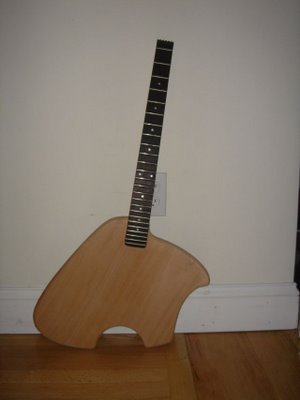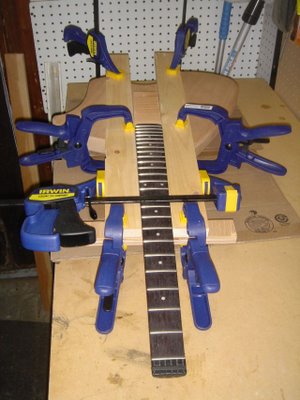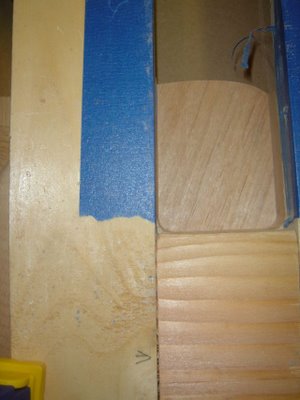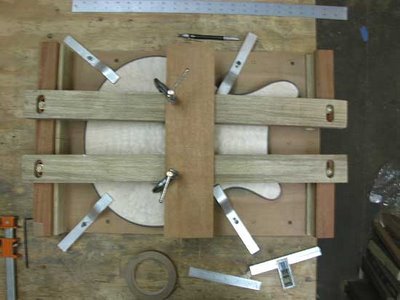Guitar Neck Pocket Complete
The guitar neck pocket is done and tight enough that I was able to hold the guitar up by its neck depending solely on its fit. By comparison, the route on the Steinberger Spirit GU-Deluxe was quite loose. Here it is with the neck attached:

Here is the setup I used to make the neck pocket. It’s derived from Martin Koch’s Building Electric Guitars.

A few passes with the DEWALT 2.25 hp Router and the neck pocket is complete:

Although the jig worked, it took more time to set up than I would have liked. This is no reflection on the idea but simply a matter of not having enough clamps on hands. For the future, rather than purchase additional clamps, I will build this neck pocket jig designed by David Myka of Myka Guitars:

This should reduce setup time and ensure a stable base from which to work. And, BTW, if you are not familiar with Myka Guitars, take a look. David does beautiful work!
More on my first guitar project:
Fascinating blog – I am really interested to see such a detailed description of your building process.
One of your other readers from Peter Budnick from Ergoweb suggested I contact you as I am in the process of designing a range of cases for guitars and violins.
I posted a question on Ergoweb about the design of my handle. Peter suggested you might have some thoughts about this.
You can see my question here
http://forum.ergoweb.com/cgi-bin/forum/gforum.cgi?post=3831;
I’d be glad to hear from you.
Hi Nick! Thanks for stopping in and thank you for the kind words! BTW, I came across your case designs a while back – I love the way they look!
I’ll hop over to Ergoweb (great resource) and check out your question…
Out of interests, How long does it take you to build a guitar?
Hexter – interesting question which I can’t quite answer just yet since this is my first build! (BTW – I’ve made no secret of that. Its been mentioned in several posts).
However, I can give you a general idea of what its taken to complete specific tasks to date. I’ve invested about 3.5 hours on two body templates. The first took about an hour. After living with it for a while, I decided I needed to make another.The second took about 2.5 hours. I was very happy with this one and the body you see is largely the result of this effort. Roughly cutting out the body took about a 1/2 hour including some very minor cleanup. Flush trimming the guitar took about another hour or so. Applying a radius with the router took another 1/2 hour to 45 minutes. The neck pocket took about a 1/2 hour to cut out. However, these numbers don’t account for several things.
The first thing that’s missing from these times is the set up time before actual execution. For example, although the neck pocket took about 1/2 hour, I spent an hour trying to set up the jig just right. Similarly, I spent substantial amounts of time setting up for other steps. With these experiences under my belt, the next builds (I actually have ideas for several floating around my brain) should take me significantly less time.
The second thing that is missing is the time taken to consider the best approach to a problem. I have spent a great deal of time both in and out of the shop figuring out ways to accomplish certain tasks. Fortunately, like the tools, jigs and templates mentioned above, this time is an investment that will pay off as I go forward.
Similarly, the third thing missing is research time. I have easily spent hundreds of hours just researching guitar building and the subject of ergonomics. Back in April and May, when my RSI injury was at its worst, all I could do was read and so I did. I still spend substantial amounts of time exploring new ideas and approaches both from a general and a task specific perspective.
Also worth mentioning are the importance of tools, jigs and templates. You have to have the right tools or at least the ability to see how you might effectively use a tool that is not obviously for a specific purpose. I haven’t always had the best tool for the job on hand which has definitely resulted in significant amounts of time devoted to planning, setup and execution. A good example was rough cutting the body. I used a jigsaw but a much better tool would have been a bandsaw. With the bandsaw, I would have been able to cut closer without worrying about the cut not being square with the top of the body blank. Because I left additional material to compensate for this, flush trimming the body took longer. Meanwhile, jigs and templates make it possible to repeat certain steps in a consistent and accurate manner. So, before I begin a second build, I will expand the number of tools, jigs and templates on hand. As I add these, I will try to make mention of them in relevant posts.
And, did I mention that I’m learning how to use some of these tools for the first time? I had never worked with a router prior to starting this build but it is the one tool that you will go to CONSTANTLY. As my skills grow with certain tools, total time to build will go down.
Questions, comments? 🙂
Great blog, I play guitar but never thought of building one,,fascinating.
Floyd – Thanks for the complement! I appreciate it. More to come this week, btw!
awesome…thanks for the run through… I think I finally have the gumption to try to make a custom guitar or two that I’ve been dreaming of for years… I’m going to start with bolt-ons. the myka guitars link was fantastic